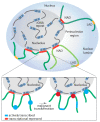The Ribosomal Gene Loci-The Power behind the Throne
- PMID: 34069807
- PMCID: PMC8157237
- DOI: 10.3390/genes12050763
The Ribosomal Gene Loci-The Power behind the Throne
Abstract
Nucleoli form around actively transcribed ribosomal RNA (rRNA) genes (rDNA), and the morphology and location of nucleolus-associated genomic domains (NADs) are linked to the RNA Polymerase I (Pol I) transcription status. The number of rDNA repeats (and the proportion of actively transcribed rRNA genes) is variable between cell types, individuals and disease state. Substantial changes in nucleolar morphology and size accompanied by concomitant changes in the Pol I transcription rate have long been documented during normal cell cycle progression, development and malignant transformation. This demonstrates how dynamic the nucleolar structure can be. Here, we will discuss how the structure of the rDNA loci, the nucleolus and the rate of Pol I transcription are important for dynamic regulation of global gene expression and genome stability, e.g., through the modulation of long-range genomic interactions with the suppressive NAD environment. These observations support an emerging paradigm whereby the rDNA repeats and the nucleolus play a key regulatory role in cellular homeostasis during normal development as well as disease, independent of their role in determining ribosome capacity and cellular growth rates.
Keywords: RNA polymerase I; cancer; cell fate; differentiation; genome architecture; heterochromatin; nucleolar associated domain (NAD); nucleolus; ribosomal genes; transcription.
Conflict of interest statement
The authors declare no conflict of interest.
Figures


Similar articles
-
Genome Organization in and around the Nucleolus.Cells. 2019 Jun 12;8(6):579. doi: 10.3390/cells8060579. Cells. 2019. PMID: 31212844 Free PMC article. Review.
-
Beyond rRNA: nucleolar transcription generates a complex network of RNAs with multiple roles in maintaining cellular homeostasis.Genes Dev. 2022 Aug 1;36(15-16):876-886. doi: 10.1101/gad.349969.122. Genes Dev. 2022. PMID: 36207140 Free PMC article. Review.
-
The nucleolus—guardian of cellular homeostasis and genome integrity.Chromosoma. 2013 Dec;122(6):487-97. doi: 10.1007/s00412-013-0430-0. Chromosoma. 2013. PMID: 24022641 Review.
-
The nucleolus: a raft adrift in the nuclear sea or the keystone in nuclear structure?Biomol Concepts. 2013 Jun;4(3):277-86. doi: 10.1515/bmc-2012-0043. Biomol Concepts. 2013. PMID: 25436580 Free PMC article. Review.
-
Structure and epigenetics of nucleoli in comparison with non-nucleolar compartments.J Histochem Cytochem. 2010 May;58(5):391-403. doi: 10.1369/jhc.2009.955435. Epub 2009 Dec 21. J Histochem Cytochem. 2010. PMID: 20026667 Free PMC article. Review.
Cited by
-
The cytidine deaminase APOBEC3A regulates nucleolar function to promote cell growth and ribosome biogenesis.PLoS Biol. 2024 Jul 8;22(7):e3002718. doi: 10.1371/journal.pbio.3002718. eCollection 2024 Jul. PLoS Biol. 2024. PMID: 38976757 Free PMC article.
-
Role of Amino Acid Arginine and Nitric Oxide in Mechanisms of Cytoprotective Effect of Non-Opiate Leu-Enkephalin Analogue In Vitro.Bull Exp Biol Med. 2021 Dec;172(2):270-275. doi: 10.1007/s10517-021-05374-2. Epub 2021 Dec 2. Bull Exp Biol Med. 2021. PMID: 34855076 Free PMC article.
-
R-Loops in Genome Instability and Cancer.Cancers (Basel). 2023 Oct 14;15(20):4986. doi: 10.3390/cancers15204986. Cancers (Basel). 2023. PMID: 37894353 Free PMC article. Review.
-
A translation control module coordinates germline stem cell differentiation with ribosome biogenesis during Drosophila oogenesis.Dev Cell. 2022 Apr 11;57(7):883-900.e10. doi: 10.1016/j.devcel.2022.03.005. Dev Cell. 2022. PMID: 35413237 Free PMC article.
-
A high-throughput assay for directly monitoring nucleolar rRNA biogenesis.Open Biol. 2022 Jan;12(1):210305. doi: 10.1098/rsob.210305. Epub 2022 Jan 26. Open Biol. 2022. PMID: 35078352 Free PMC article.
References
-
- Merz K., Hondele M., Goetze H., Gmelch K., Stoeckl U., Griesenbeck J. Actively transcribed rRNA genes in S. cerevisiae are organized in a specialized chromatin associated with the high-mobility group protein Hmo1 and are largely devoid of histone molecules. Genes Dev. 2008;22:1190–1204. doi: 10.1101/gad.466908. - DOI - PMC - PubMed
Publication types
MeSH terms
LinkOut - more resources
Full Text Sources

